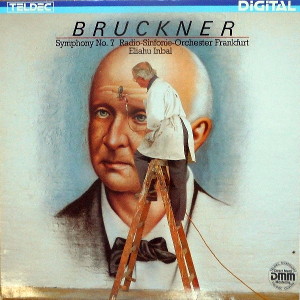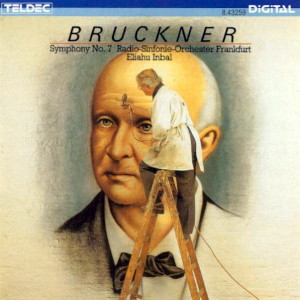 |
|
1 LP -
6.43259 AZ - (p) 1986
|
 |
| 1 CD -
8.43259 ZK - (p) 1986 |
|
| ANTON BRUCKNER
(1824-1896) |
|
|
|
|
|
| Symphonie
Nr. 7 E-dur |
63' 28" |
|
-
Allegro moderato
|
19' 24" |
|
| -
Adagio: Sehr feierlich und sehr
langsam |
23' 31" |
|
| -
Scherzo: Sehr schnell |
9' 39" |
|
| -
Finale: Bewegt, doch nicht schnell |
10'
54" |
|
|
|
|
| Radio-Sinfonie-Orchester
Frankfurt |
|
| Elihau Inbal,
Leitung |
|
|
|
|
|
Luogo
e data di registrazione |
|
Frankfurt
(Germania) - settembre 1985 |
|
|
Registrazione:
live / studio |
|
studio |
|
|
Producer /
Engineer |
|
- |
|
|
Prima Edizione LP |
|
Teldec
- 6.43259 AZ - (1 LP) - durata 63'
28" - (p) 1986 - Digitale |
|
|
Prima Edizione CD |
|
Teldec
- 8.43259 ZK - (1 CD) - durata 63'
28" - (p) 1986 - DDD |
|
|
Note |
|
Co-Produktion
mit dem HR, Franfurt.
|
|
|
|
|
Perhaps even
more than the Third Symphony
with the quotations from
Wagner opera woven into its
original version, Bruckner’s
Seventh Symphony is his true
“Wagner Symphony”. And this
not just on account of the
“funeral music” in the
Adagio, which Bruckner
composed in 1833
after leaming of the revered
master’s death. The musical
language as well, the
melodic realisation of some
ideas, or the extensively
used alteration harmonics
give the Seventh a
particular affinity to
Wagner’s music. “Bruckner is
the latest idol of the
Wagnerians” - thus the
personal opinion of the
critic Eduard Hanslick, who
held Bruckner in no high
regard, after the Seventh
Symphony’s Vienna premiere
with Hans Richter.
Bruckner had worked on the
symphony for two years; in
September 1883
the score was finally ready
in a fair copy. But a
perfonnance was still out of
the question at this point,
leading the oomposer’s
pupils Joseph Schalk and
Ferdinand Löwe
to play the new work for
those interested on two
pianos in Vienna’s Bösendorfer
Saal on 27th February 1884.
The first orchestral
performance was not to take
place until the end of that
year in Leipzig. On the
occasion of the Second
Symphony’s première,
Arthur Nikisch was still
seated among the violinists
of the Vienna Philharmonic.
Now, at the age of just 29,
he held the conductor’s
baton at the perfonnance of
the new Bruckner Symphony on
30th December 1884
in Leipzig.
After a flickering tremolo
on the violins, the majestic
main theme is introduced in
the third bar; oboes and
clarinets bring in the
close-knit second subject.
Dissonant tension is finally
resolved with the soothing
third subject, which wipes
out all solemnity for a few
moments with its dance-like
character. Bruckner
elaborates the three
contrasting themes in the
development with stretti and
inversions. The Coda, too,
is striking; over the
pedal-note E on the
kettledrum soars the opening
of the main theme at the end
like a colossal dome.
,,Sehr feierlich und sehr
langsam“, very solemn and
very slow: thus begins the
Adagio with a theme played
by the low strings and
Wagner tubas, which is then
continued “sehr markig”,
with great emphasis, on the
full-sounding G string of
the first violins. A few
bars of “brooding”
chromatics lead into the
more relaxed F sharp major
theme. In the reprise
Bruckner endeavours to bathe
the intensively expressive
main subject in a milder
light through a veil of
sextuplets on the first
violins, before sounds of
profound sadness are heard
again in the Coda, the
“funeral music in memory of
the Master’s passing away”.
A few years ago Constantin
Floros pointed out
remarkable similarities with
the funeral march in “Götterdämmerung”.
The Scherzo
is constructed according
to the classical scheme.
The trumpet intones a
signal-like reveille over
an urgent unison figure on
the strings: the rhythm of
the trumpet call passes
over to the kettledrum at
one point, and even whisks
spookily through the Trio.
- In the Finale the main
subject with its striking
vigour finds its ‘final
fonn’, as if carved out
specially, in the unison
of the third subject. In
between Bruckner brings in
a chorale
in solemn four- part
writing for the strings. A
last point worthy of note
is the reference back to
the first movement: a few
bars before the end, the
opening of its main
subject surges through the
Coda’s flood of musc.
This recording of
Bruckner’s Seventh
Symphony follows the score
published in 1954 by
Leopold Nowak, i.e. that
of the autograph
manuscript in the Austrian
National Library. Like
Robert Haas and Alfred
Orel, Nowak too was
interested in the original
version of the symphonies
in each case, although for
the Seventh this differs
from the first printed
edition only on minor
points.
Hans
Christoph Worbs
Translation:
C. R. Williams
|
|
|